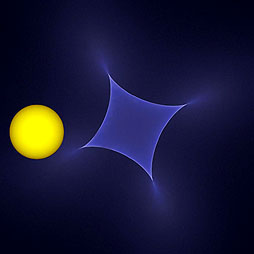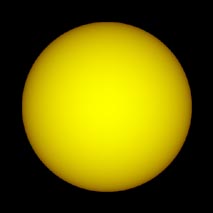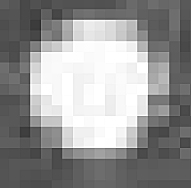STELLAR ATMOSPHERES
Gravitational microlensing may be used to probe the surfaces of stars. In events where the lens is a binary star, a ‘caustic’ is formed (Schneider & Weiss, A&A, Vol. 164, p. 237). This is a closed curve of very high magnification. If the source star moves through a caustic, the star is profiled twice, as it enters and exits the caustic.
The technique, which has been used extensively by the PLANET group, is illustrated by event MOA 2002-BLG-33 below. For this event the source star was a solar-like star, and the lens was a close binary. The measured profiles of the source star in two passbands were found to be consistent with current stellar atmosphere theory to within an accuracy of 4%, confirming the efficacy of the technique.

Caustic and source star for event MOA 2002-BLG-33. The image of the source star was constructed from measured profiles in visual and infrared passbands. The magnification caused by the binary lens is represented by blue shading, with regions of higher magnification represented by lighter shading. The caustic is the closed white curve. The source star moved horizontally, left to right, through the caustic in 15.6 hours. Further details are at astro-ph/0310410.
MOA 2002-BLG-33 was unusual because the size of the caustic was similar to the size of
the source star. This enabled the shape of the source star to be measured. It was found to
differ from circularity by less than a few percent. The final image of the star is shown below.
 The resolution is 0.04 micro arcsec - the resolution required to read this website
from the moon! Further details are at Astro-ph/0506013. It is the sharpest image of any
star, save the sun. The star is actually quite similar to the sun, but located 15,000 light years away in
Sagittarius. An image of the same star as recorded by the Hubble Space
The resolution is 0.04 micro arcsec - the resolution required to read this website
from the moon! Further details are at Astro-ph/0506013. It is the sharpest image of any
star, save the sun. The star is actually quite similar to the sun, but located 15,000 light years away in
Sagittarius. An image of the same star as recorded by the Hubble Space
 Telescope is shown for comparison at the right. The
image by microlensing is approximately 2 micro arcsec in diameter, the true angular size of the star, whereas the
HST image is smeared out to a diameter of approximately 0.3 arcsecs due to the effect of diffraction.
Telescope is shown for comparison at the right. The
image by microlensing is approximately 2 micro arcsec in diameter, the true angular size of the star, whereas the
HST image is smeared out to a diameter of approximately 0.3 arcsecs due to the effect of diffraction.
